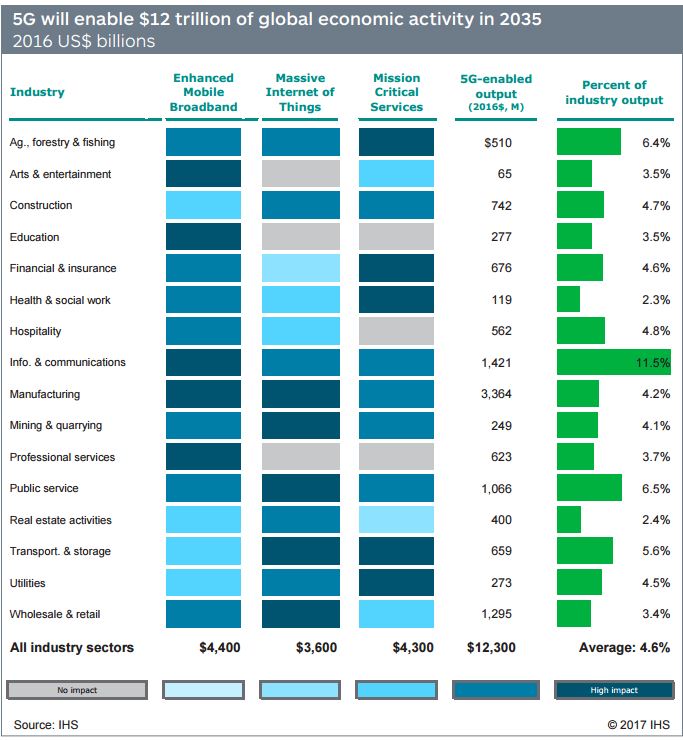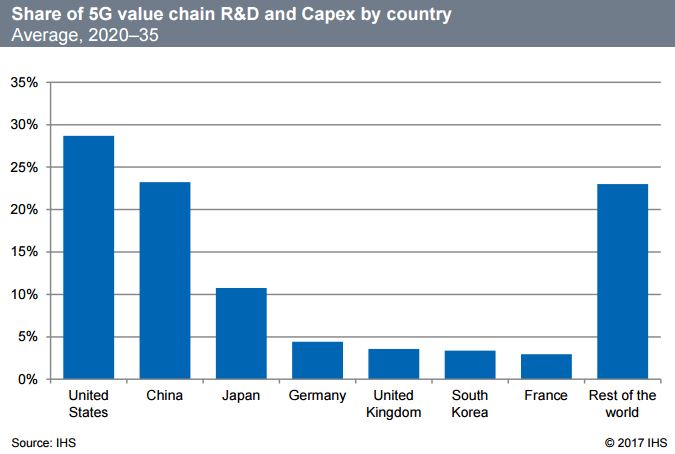Where SMS Fits in 5G
Nor do mobile usage patterns so far indicate that one type of communication has ever fully replaced others that came before it; rather, they exist in parallel, each developing its own market and use case. For example, Snapchat has not made text-only messaging extinct but rather has a distinctly different purpose -- easier explained through example. When your boss wants to tell you she is running late for your appointment, she probably won't do it with frown graphics over her photo, instead using just the words as fast as she can get them to you. By contrast, a classmate might convey the same message using the former -- with graphics, rather than just text. Choices for communications methods might expand in 5G -- mobile subscriptions would include suites of services to accommodate a diversification of communication methods: messages between applications and people, and between people and Internet devices.
These estimates about the size of the 5G economy come from a report by Qualcomm and IHS Markit.
Not Either-Or
So the growth of 5G means more SMS. And get this: the amount of economic output that 5G will generate in 2035 will equal the value of all U.S. consumer spending today. That year, the technology could generate $12.3 trillion in economic activity, creating up to 22 million jobs worldwide, according to a report by Qualcomm and IHS Markit. And before you start rationalizing that your industry, customers, or geography won't have any relevance, know this: Even fields like agriculture, forestry and fishing will have $510 billion in 5G- enabled output that year -- mind you, this figure is expressed in 2016 dollars. But still, think about it.Major Disruption
Indeed, this mobile technology could have a stronger disruptive impact than all preceding it; this generation not only speeds up transmissions and enables a wider range of file types, but also connects a much broader assortment of devices than phones and tablets -- anything and everything equipped with a computer chip and web connectivity, otherwise known as the Internet of Things (IoT). Only imagine more types of gizmos than today's IoT category includes. That's a lot to connect, which won't happen overnight. Up to 20 markets worldwide might have 5G by 2021, although the U.S., Japan, China and South Korea will have the vast majority of subscribers, due to the fact that mobile carriers in these countries are moving faster than in other parts of the world.
Here's a breakdown on the size of the 5G economy by country, in 2035.
Traffic Report
Even if you can't see 5G having an impact on your business today, the driver of this upgrade are hard to miss: The digital equivalent of a global traffic jam. Mobile data traffic has grown 18-fold over the past half decade, according to Cisco. The vendor reports that global mobile data traffic reached 7.2 exabytes (equivalent to 7.2 billion gigabytes) per month at the end of 2016. Here comes an even more telling statistic from Cisco:Mobile offload exceeded cellular traffic by a significant margin in 2016. Sixty percent of total mobile data traffic was offloaded onto the fixed network through Wi-Fi or femtocell in 2016. In total, 10.7 exabytes of mobile data traffic were offloaded onto the fixed network each month.In other words, today's networks cannot keep up with traffic. The fact that demand is essentially maxing out supply makes SMS messaging attractive compared to other communications technologies: Bandwidth efficiency will keep SMS relevant for a long time to come. Speaking of efficiency and long-term relevance, implementing SMS is easier than ever using RingCaptcha. Click here to learn more.


 Notifications
Notifications 

